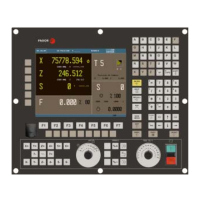·328·
Installation manual
CNC 8055
CNC 8055i
7.
CONCEPTS
SOFT: V02.2X
Axis setting
7.5.7 Leadscrew error compensation
The CNC provides a table for each one of the axes requiring leadscrew compensation. It is possible
to define different compensation values for each moving direction. This type of compensation is
activated by setting axis parameter LSCRWCOM (P15)=ON for the desired axis.
The CNC enables one leadscrew error compensation table for each axis. The number of elements
of the table is determined by the axis parameter NPOINTS (P16), being possible to define up to 1000
points per axis.
Each parameter of the table represents a point of the profile to compensate. The following
information is defined at each point:
• The position occupied by the point in the profile (position to compensate). It is defined by its
coordinate referred to machine zero. Possible values ±99999.9999 mm or ±3937.00787 inches.
• The amount of error of the axis in this point in the positive direction. Possible values ±99999.9999
mm or ±3937.00787 inches.
• The amount of error of the axis in this point in the negative direction. Possible values
±99999.9999 mm or ±3937.00787 inches.
For each axis position, define the amount of error to be compensated in both directions. If the error
in the negative direction is zero for all the points, it assumes that the error defined for the positive
direction is good for both directions.
Leadscrew error compensation on rotary axes
On rotary axes, although the display is limited between 0 and 360º, the internal count is
accumulative. When using leadscrew error compensation, set positions 0° and 360°, first and last
point of the table, with the same amount of error. This way, the CNC will apply the same
compensation in all the revolutions.
Otherwise, the compensation will be limited to the indicated field.
Considerations and limitations
When defining the profile points in the table, the following requirements must be met:
• The axis points must be in sequential order starting from the most negative (least positive) point
to be compensated.
• For those points outside the compensation zone, the CNC will apply the compensation value
corresponding to the table point closest to them.
• The amount of error of the machine reference point may have any value.
• The error difference between two consecutive points must not be greater than the distance
between them (maximum slope= 100%).
Setting example
The X axis leadscrew must be compensated in the positive direction for between X-20 and X160
according to the leadscrew error graph below:

